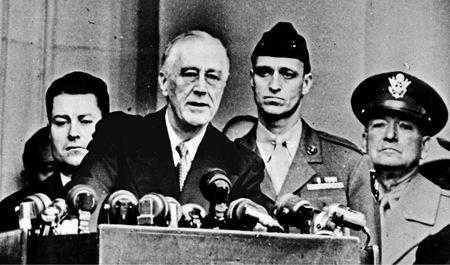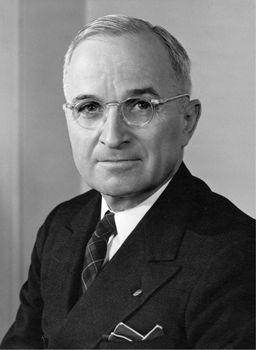Killing Patton The Strange Death of World War II's Most Audacious General (22 page)
Read Killing Patton The Strange Death of World War II's Most Audacious General Online
Authors: Bill O'Reilly
Tags: #Biographies & Memoirs, #Historical, #United States, #Leaders & Notable People, #Military, #World War II, #History, #Americas, #Professionals & Academics, #Military & Spies, #20th Century


American tank destroyers prepare to advance on Bastogne in January 1945
Rather than simply race through the town, Abrams chooses to level it. Every building that might conceal a German becomes a target. The Shermans load and shoot their big 76 mm guns as many as seven times per minute. Meanwhile, the infantry ruthlessly hunts down Germans, screaming, “Come out,” to induce them to surrender.
“But they wouldn’t,” one American soldier later remembers. “One poked his head out of a foxhole and I shot him in the neck.”
Trouble soon strikes. The jeep carrying the artillery observer is hit before he can give the signal to halt the barrage. The American artillery continues to rain down shells on Assenois, unaware that Abrams and his men are now inside the town. Three hundred and sixty rounds of artillery shells are fired by the American big guns. Geysers of earth erupt throughout the town as each shell forms its own deep crater. Frantic radio calls from Lt. Charles Boggess, who now leads Abrams’s spearhead in his tank, Cobra King, go unheard. Americans and Germans both are killed. The American shelling and the nonstop tank barrage are completely decimating Assenois, wiping it off the map as if it never existed. Plumes of fiery smoke and dust turn the daytime sky black. Finally, a spotter plane pilot sees the trouble and orders the artillery to stop.
The Germans lay Teller antitank mines on the road in a last-ditch effort to stop the American breakthrough. None of the Shermans is hit, but an American halftrack explodes when it hits a mine, killing the driver and again bringing the American column to a complete halt. Thinking quickly, Capt. William Dwight, Abrams’s operations officer, risks his life by climbing out of his tank and exposing himself to fire as he clears the mines out of the road by hand.
Through the dust and smoke, Pvt. James R. Hendrix, the son of an Arkansas sharecropper, spots two concealed German 88 mm guns. Next to them, hiding in a foxhole, are two Wehrmacht soldiers. Hendrix crouches low and moves toward them through a hedgerow, then presses his body flat in a shell crater as he creeps up on the enemy. Hendrix is just five foot six, and weighs only 125 pounds, but he shows no fear as he prepares to attack the German foxhole alone.
“A feller just figures if it’s his time, it’s his time, and that’s all there is to it,” is how he later explains his courage.
Screaming, “Kommen heraus!”—“Come out!” in German—Hendrix runs up to the foxhole with his M-1 aimed squarely at the enemy soldiers.
They don’t surrender. Hendrix is forced to shoot one soldier in the head and then smash in the skull of the other with his rifle butt.
“I got their guns and got back in my shell hole and started hollering, ‘Kommen heraus,’ again, and sure enough, them Germans began coming out from around the different foxholes, and 13 gave up,” he will later recall, describing the action that will earn him the Congressional Medal of Honor.
Later that night, in fierce, pitch-black fighting that will see few prisoners taken on either side, Hendrix will add to his legacy by personally knocking out two German machine-gun nests and also braving sniper fire to pull a wounded American from a burning halftrack.
2
The battle in the forests surrounding Assenois will continue long into the night, but by afternoon the Americans have carved a small channel through the German lines. The path is less than four hundred yards wide, and Germans are poised on both sides, prepared to counterattack and once again close the road. But for now, American tanks are advancing toward Bastogne.
Boggess fires on a German pillbox on the outskirts of Bastogne. The smoke clears. First Lieutenant Charles Boggess opens the turret of Cobra King and lifts his torso up through the opening. Soldiers in uniform crouch in foxholes across the road to his right, their guns aimed his way. “Come here! Come on out! This is the Fourth Armored,” he shouts. He does not yell in German, hoping to find an American reply.
There is no answer. A tense moment passes. With his head and chest completely exposed to rifle fire, Lieutenant Boggess considers his options.
The Sherman 76 mm barrel pivots until it is aimed directly at the foxholes. Pvt. James G. Murphy has already loaded a round, and the gunner, Cpl. Milton Dickerman, awaits the order to fire.
“Come on out!” Boggess nervously shouts again.
A lone soldier walks forward.
“I’m Lieutenant Webster, of the 326th Engineers, 101st Airborne Division,” he said. “Glad to see you.”
Bastogne has officially been relieved.
Cobra King rolls into the heart of the town, followed by a convoy of Sherman tanks.
Soon, “Abe” Abrams appears.
“Gee, am I mighty glad to see you,” says Tony McAuliffe.
Patton’s audacious gamble has succeeded. He awards Abrams with the equivalent of a second Distinguished Service Cross and praises him as America’s top tank commander—even saying that Abrams is a better tank commander than he.
* * *
The next morning, December 27, 1944, George Patton once again walks to the front of a small Catholic chapel and drops to his knees in prayer.
“Sir, this is Patton again,” he begins with an air of contrition. “And I beg to report complete progress. Sir, it seems to me that You have been much better informed about the situation than I was, because it was that awful weather which I cursed You so much which made it possible for the German army to commit suicide. That, Sir, was a brilliant military move,
3
and I bow humbly to Your supreme genius.”
4
* * *
The German advance stalled on Christmas Eve 1944. Basically, the Germans overran their supply lines. And without ammunition and gasoline, they were unable to wage an offensive campaign. The continued progress of Patton and his Third Army eventually spelled doom for Operation Watch on the Rhine. By January 25, 1945, the Germans had retreated back to the same positions they had held at the start of the offensive six weeks earlier. Thus ended the last great German attack on the Western Front. “The relief of Bastogne is the most brilliant operation we have thus far performed, and is in my opinion the outstanding achievement of this war,” Patton writes home to his wife, Beatrice.
“Now the enemy must dance to our tune, not we to his.”
13
W
HITE
H
OUSE
W
ASHINGTON,
DC
J
ANUARY
20, 1945
1
11:55
A.M.
War is never far from the minds of Americans, even on a unique day in the nation’s history.
Hope that the Second World War would end by New Year’s Day has long been abandoned. Wounded soldiers, many on crutches, are among the seven thousand invited guests tromping through harsh weather to witness Franklin Delano Roosevelt’s swearing-in as president of the United States. This will be the first inaugural address during wartime since Abraham Lincoln spoke eighty years ago, in 1865. Also, this is the first inaugural to be held at the White House, in “the president’s backyard,” as the South Lawn is known. Finally, this is the first and only time an American president will be sworn in for a fourth term.
A light snow dusts the White House on this Saturday morning as spectators show their invitations to the security guards, then pass onto the wintry lawn. It stopped snowing three hours ago, but the skies are threatening yet another storm. No seats await, so the seven thousand guests remain standing—even those soldiers balancing on crutches. Thirteen of Roosevelt’s grandchildren pose for a newsreel cameraman atop the stairs of the South Portico, just a few steps from the podium. FDR’s chief of staff, Harry Hopkins, stands ground level at the bottom of the stairs, fastidiously overseeing the proceedings.

President Roosevelt speaking at his fourth inauguration ceremony
In addition to the veterans and dignitaries,
2
a smattering of black faces can be seen in the crowd, reflecting Roosevelt’s hope for a more racially integrated nation. The diverse attendees stand side by side in the elements, awaiting the noon start. Wartime shortages of gasoline and lumber mean that the traditional post-inaugural parade will not happen, and the swearing-in ceremony promises to be brisk.
As the seconds tick down, the crowd presses closer and closer to the White House walls. Only a thin barrier of Secret Service agents and Washington, DC, police protect the curved outcropping known as the South Portico.
At the stroke of twelve, Rev. Angus Dun steps to the lectern to begin the proceedings. The Right Reverend is bishop of the Protestant Episcopal Diocese of Washington. Dun is a pacifist, which makes him an odd selection to deliver the invocation in a time of all-out war. Even more intriguing, Dun is visibly handicapped. He balances on crutches, having lost one leg to polio. His hands and remaining foot are deformed. Perhaps it can be said that the clergy is the only profession that would embrace a handicapped individual in this day and age, yet the fact remains that Dun has prospered. And unlike President Roosevelt, who would never dare reveal his handicap, Angus Dun
3
does not hide who he is. Thus it is fitting that just eighty-three days hence, at a time when such fears will be completely meaningless to FDR, Angus Dun will also lead prayers at the president’s funeral service.
* * *
Harry S. Truman, the sixty-year-old senator from Missouri, steps to the lectern to be sworn in as vice president. This is a time of austerity in America and around the world, so Truman and Roosevelt have chosen to forgo formal dress, preferring instead to wear dark business suits.
The new vice president places his left hand on a family Bible and raises his right to take the oath of office. He is a small, wiry man with an infectious grin, a man unafraid to cry in public but able to conceal his emotions when a situation turns competitive. Those unlucky enough to sit across the poker table from Harry S. Truman know this all too well. The
S
does not stand for anything; that single letter is his actual middle name. It was once Truman’s dream to attend West Point, but poor eyesight ended that ambition, making necessary the glasses he now wears. Truman, however, fought as an officer in the First World War. He aced the vision exam before his induction into the military by memorizing the eye chart.

President Harry S. Truman in 1945
Truman made the leap from a small-time county commissioner to Missouri senator just ten years ago. And at times the power in Washington still overwhelms him. Now is such a moment. He and FDR barely know each other, and the president clearly has no interest in asking Truman’s advice about how to run the country. It is also widely known that Truman did not campaign for this new job. In fact, he was initially reluctant to accept the vice president’s spot on the ticket when it was offered at the Democratic Convention last July. Foreseeing his own death, FDR had sought to replace his current vice president, Iowa native Henry Wallace, with someone less liberal and less inclined to align himself too closely with the labor movement. Roosevelt studied the dossiers of several candidates before settling on the pragmatic Truman.
